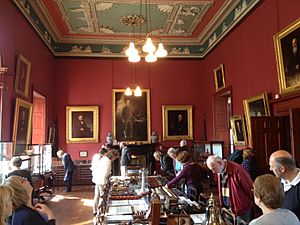Trinity House of Leith facts for kids
Quick facts for kids Trinity House of Leith |
|
|---|---|
 |
|
| Location | Leith, Edinburgh |
| Built | 1818 |
| Architect | Thomas Brown |
| Architectural style(s) | Neoclassical style |
|
Listed Building – Category A
|
|
| Designated | 14 December 1970 |
| Reference no. | LB27834 |
| Lua error in Module:Location_map at line 420: attempt to index field 'wikibase' (a nil value). | |
Trinity House, located at 99 Kirkgate in Leith, Edinburgh, Scotland, is a very old and important building. For many years, it served as a meeting place for sailors' groups, a customs office, and a center for managing sea activities. It also helped people in need. Long ago, it was even a place for the sick and poor, like a hospital.
Today, Trinity House is looked after by Historic Scotland, a government agency that cares for historic sites. It is now a fascinating maritime museum, where you can learn about the sea and ships. This building is so special that it's officially recognized as a Category A listed building, meaning it's one of Scotland's most important historic sites.
Contents
History of Trinity House
Helping Sailors and Their Families
Back in 1380, King Robert II gave a special group called the "Incorporation of Master and Mariners of Leith" the right to collect a small tax. This tax, called "prime gilt," was 12 pennies for every ton of goods brought into Leith by ship. They also collected extra money called "crown money," which people gave voluntarily.
- This money was used to help people.
- It supported sailors who were sick or old.
- It also helped the widows and children of sailors who were lost at sea or captured.
The Masters and Mariners of Trinity House became the oldest and wealthiest of Leith's trade groups. They traded mostly across the North Sea with countries like Norway, Sweden, Denmark, and places around the Baltic Sea, as well as the Netherlands and France.
Building the First Trinity House
The north wall of Trinity House has a stone that says it was built in 1555. Some older stories say it was built in 1560. It replaced an old fortified building called "St Anthony's blockhouse." This blockhouse was destroyed in 1560, but its strong underground rooms still exist beneath Trinity House today.
In 1566, after some arguments about payments, Mary Queen of Scots officially confirmed the right of the Incorporation to collect money. She made sure they could continue their work of helping people. If someone refused to pay, their ship's sails and anchor could be taken away!
The idea of Trinity House was so good that other port cities, like Newcastle-upon-Tyne, started their own similar organizations in the 1500s.
Training and Lighthouses
In 1680, the Masters and Mariners used their funds to hire a teacher. This teacher taught the math needed for navigation to the sons and apprentices of shipmasters. This was an important step in improving safety at sea.
Trinity House also started the first formal nautical training in Scotland. They licensed pilots to guide ships safely through the Firth of Forth and along the Scottish coast. They collected "Licht Money" (light money) to maintain early coal-fired lights in the Forth.
- In the 1800s, Trinity House helped plan and pay for new, better lighthouses.
- These lighthouses used new technology to make the seas safer.
- Famous lighthouses they helped with include the Bell Rock lighthouse, Fidra lighthouse, and the Isle of May lighthouse.
On June 29, 1797, Trinity House received a royal charter. This made them an official corporation with more responsibilities. They gained the power to choose and license harbor pilots. Their right to collect taxes was also confirmed. They charged one penny for every ton of goods unloaded, using this money to help the poor. Each shipmaster also paid sixpence a year, which went directly to poor sailors.
In the 1700s, the Masters and Mariners bought land near Newhaven. This land became known as Trinity Mains. Over time, it grew into a part of Leith and is now the district of Trinity.
Modern Education and Legacy
In 1844, a new law called the Merchant Seamen Act 1844 required sailors to have formal qualifications. Because of this, in 1855, Trinity House and other groups in Leith started the Leith Navigational School. This school taught navigation and was first located at St Ninian's Church.
In 1903, the school came under the control of the Scottish Education Department. Its name changed to Leith Nautical College. This college later merged with other schools and is now part of Edinburgh College.
After the "prime gilt" tax was stopped in 1862, Trinity House relied on income from its properties to pay pensions and other commitments.
Today, students from the nearby Leith Primary School learn about the history of Trinity House. They even give tours of the building to other schools and special guests!
The Current Building
The Incorporation had enough money to build a hospital at the Kirkgate in 1555. The strong basement and arched rooms of that 16th-century building are still part of the current structure. The building you see today was designed by Thomas Brown. It was completed in 1818 in the Neoclassical style, which is a grand style inspired by ancient Greek and Roman buildings.
- The front of the building has three sections.
- It features a porch with pairs of Doric order columns on the ground floor.
- Above, on the first floor, there is a large window with Ionic order columns and a beautiful semi-circular fanlight window.
See also


